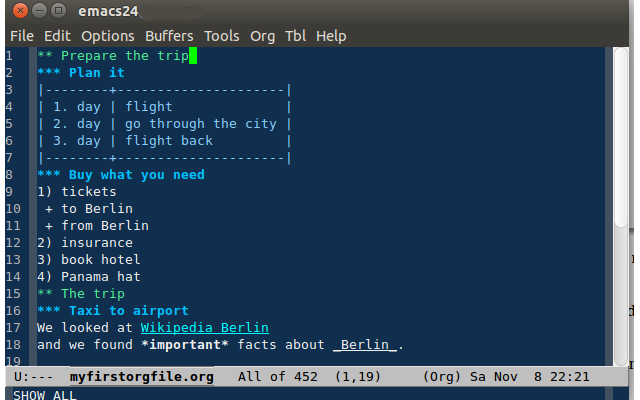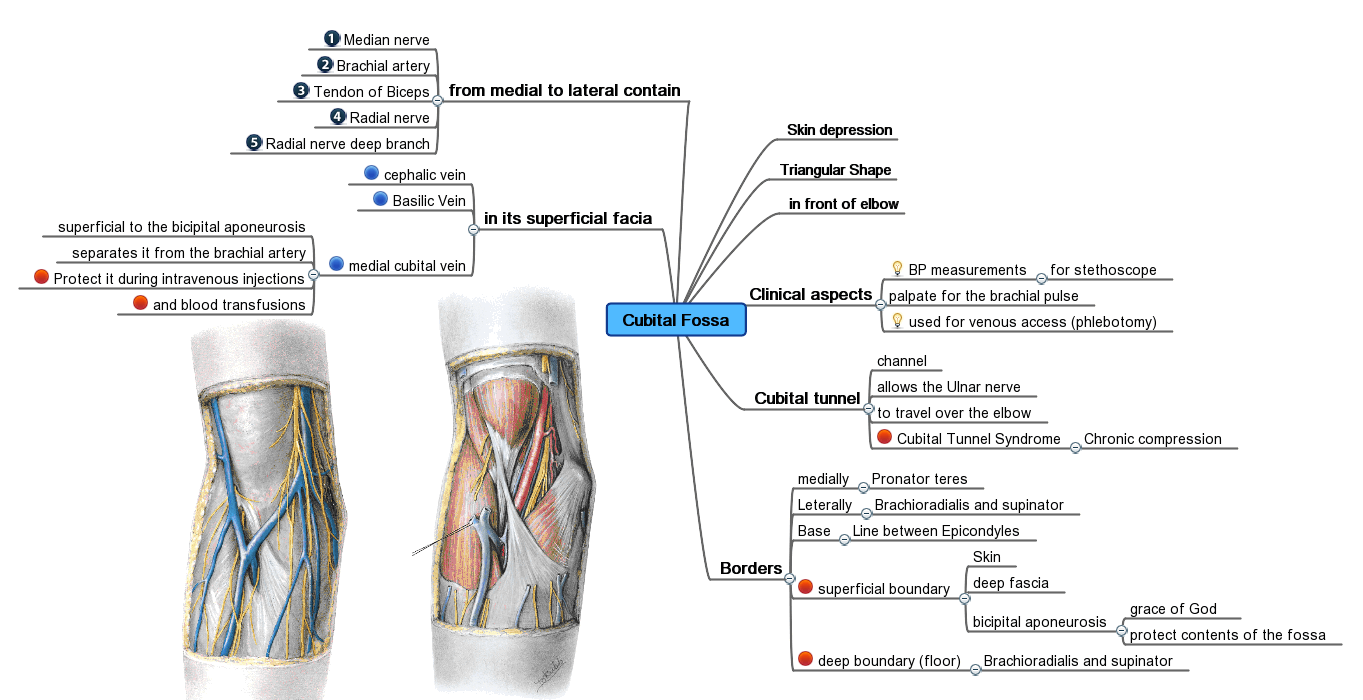|
Freeplane
Freeplane is a free, open source software application for creating mind maps (diagrams of connections between ideas), and electronic outlines. Written in Java, it is supported on Windows, Mac OS X and Linux, and is licensed under the GNU GPL version "2 or later". In 2007, Freeplane was forked from the FreeMind project. Freeplane maintains partial file format compatibility with FreeMind, fully supporting the FreeMind XML file format, but adds features and tags not supported by FreeMind, which FreeMind ignores on loading. Features Release 1.1 New features of Freeplane stable release (June 2010) include: * Export to PNG, JPEG, SVG (in addition to HTML / XHTML and PDF) * Find / Replace in all open maps * Paste HTML as node structure * Outline mode * Portable version (run from a USB flash drive) * Scripting via Groovy * Spell checker Release 1.2.x The first stable Freeplane 1.2.x was 1.2.20 released on October 20, 2012. It includes the following new features: * Text proc ... [...More Info...] [...Related Items...] OR: [Wikipedia] [Google] [Baidu] |
FreeMind
FreeMind is a free mind mapping application written in Java, which is further developed by the fork Freeplane until today (2021). FreeMind itself was last updated in 2014. FreeMind is licensed under the GNU General Public License Version 2. It provides extensive export capabilities. It runs on Microsoft Windows, Linux, and macOS via the Java Runtime Environment. As with other mind mapping software packages, FreeMind allows the user to edit a hierarchical set of ideas around a central concept. The non-linear approach assists in brainstorming new outlines and projects as ideas are added around the mind map. As a Java application, FreeMind is portable across multiple platforms and retains the same user interface, causing some amount of variation from the common interface on each platform. Mac users may notice the most difference from their traditional user interface, but a MacWorld reviewer says the software's features should still appeal to the segment of users who accept funct ... [...More Info...] [...Related Items...] OR: [Wikipedia] [Google] [Baidu] |
List Of Mind Mapping Software
Concept mapping and mind mapping software is used to create diagrams of relationships between concepts, ideas, or other pieces of information. It has been suggested that the mind mapping technique can improve learning and study efficiency up to 15% over conventional note-taking. Many software packages and websites allow creating or otherwise supporting mind maps. File format Using a standard file format allows interchange of files between various programs. Many programs listed below support the OPML file format and the XML file format used by FreeMind. Free and open-source The following tools comply with the Free Software Foundation's (FSF) definition of free software. As such, they are also open-source software. Freeware The following is a list of notable concept mapping and mind mapping applications which are freeware and available at no cost. Some are open source and others are proprietary software. Proprietary software The table below lists pieces of proprietary co ... [...More Info...] [...Related Items...] OR: [Wikipedia] [Google] [Baidu] |
Outliner
An outliner (or outline processor) is a specialized type of text editor (word processor) used to create and edit outlines, which are text files which have a tree structure, for organization. Textual information is contained in discrete sections called "nodes", which are arranged according to their topic–subtopic (parent–child) relationships, like the members of a family tree. When loaded into an outliner, an outline may be collapsed or expanded to display as few or as many levels as desired. Outliners are used for storing and retrieving textual information, with terms, phrases, sentences, or paragraphs attached to a tree. So rather than being arranged by document, information is arranged by topic or content. An outline in an outliner may contain as many topics as desired. This eliminates the need to have separate documents, as outlines easily include other outlines just by adding to the tree. The main difference between a hand-written outline and a digital one is that the ... [...More Info...] [...Related Items...] OR: [Wikipedia] [Google] [Baidu] |
Cross-platform
In computing, cross-platform software (also called multi-platform software, platform-agnostic software, or platform-independent software) is computer software that is designed to work in several computing platforms. Some cross-platform software requires a separate build for each platform, but some can be directly run on any platform without special preparation, being written in an interpreted language or compiled to portable bytecode for which the interpreters or run-time packages are common or standard components of all supported platforms. For example, a cross-platform application may run on Microsoft Windows, Linux, and macOS. Cross-platform software may run on many platforms, or as few as two. Some frameworks for cross-platform development are Codename One, Kivy, Qt, Flutter, NativeScript, Xamarin, Phonegap, Ionic, and React Native. Platforms ''Platform'' can refer to the type of processor (CPU) or other hardware on which an operating system (OS) or applicatio ... [...More Info...] [...Related Items...] OR: [Wikipedia] [Google] [Baidu] |
Groovy (programming Language)
Apache Groovy is a Java-syntax-compatible object-oriented programming language for the Java platform. It is both a static and dynamic language with features similar to those of Python, Ruby, and Smalltalk. It can be used as both a programming language and a scripting language for the Java Platform, is compiled to Java virtual machine (JVM) bytecode, and interoperates seamlessly with other Java code and libraries. Groovy uses a curly-bracket syntax similar to Java's. Groovy supports closures, multiline strings, and expressions embedded in strings. Much of Groovy's power lies in its AST transformations, triggered through annotations. Groovy 1.0 was released on January 2, 2007, and Groovy 2.0 in July, 2012. Since version 2, Groovy can be compiled statically, offering type inference and performance near that of Java. Groovy 2.4 was the last major release under Pivotal Software's sponsorship which ended in March 2015. Groovy has since changed its governance structure to a Proje ... [...More Info...] [...Related Items...] OR: [Wikipedia] [Google] [Baidu] |
Free Note-taking Software
Free may refer to: Concept * Freedom, having the ability to do something, without having to obey anyone/anything * Freethought, a position that beliefs should be formed only on the basis of logic, reason, and empiricism * Emancipate, to procure political rights, as for a disenfranchised group * Free will, control exercised by rational agents over their actions and decisions * Free of charge, also known as gratis. See Gratis vs libre. Computing * Free (programming), a function that releases dynamically allocated memory for reuse * Free format, a file format which can be used without restrictions * Free software, software usable and distributable with few restrictions and no payment * Freeware, a broader class of software available at no cost Mathematics * Free object ** Free abelian group ** Free algebra ** Free group ** Free module ** Free semigroup * Free variable People * Free (surname) * Free (rapper) (born 1968), or Free Marie, American rapper and media personal ... [...More Info...] [...Related Items...] OR: [Wikipedia] [Google] [Baidu] |
Note-taking Software
The tables below compare features of notable note-taking software. General information Basic features Advanced formatting and content See also * Comparison of text editors * Comparison of web annotation systems * Comparison of wiki software * Comparison of word processors * List of personal information managers * List of text editors * List of wiki software * Outliner * Personal information manager * Personal knowledge base Notes References External links * {{DEFAULTSORT:Comparison Of Notetaking Software Notetaking software The tables below compare features of notable note-taking software. General information Basic features Advanced formatting and content See also * Comparison of text editors * Comparison of web annotation systems * Comparison of wiki soft ... Note-taking Text editor comparisons ... [...More Info...] [...Related Items...] OR: [Wikipedia] [Google] [Baidu] |
Mind-mapping Software
A mind map is a diagram used to visually organize information into a hierarchy, showing relationships among pieces of the whole. It is often created around a single concept, drawn as an image in the center of a blank page, to which associated representations of ideas such as images, words and parts of words are added. Major ideas are connected directly to the central concept, and other ideas branch out from those major ideas. Mind maps can also be drawn by hand, either as "notes" during a lecture, meeting or planning session, for example, or as higher quality pictures when more time is available. Mind maps are considered to be a type of spider diagram. Origins Although the term "mind map" was first popularized by British popular psychology author and television personality Tony Buzan, the use of diagrams that visually "map" information using branching and radial maps traces back centuries. These pictorial methods record knowledge and model systems, and have a long history in ... [...More Info...] [...Related Items...] OR: [Wikipedia] [Google] [Baidu] |
Concept Mapping Software
Concepts are defined as abstract ideas. They are understood to be the fundamental building blocks of the concept behind principles, thoughts and beliefs. They play an important role in all aspects of cognition. As such, concepts are studied by several disciplines, such as linguistics, psychology, and philosophy, and these disciplines are interested in the logical and psychological structure of concepts, and how they are put together to form thoughts and sentences. The study of concepts has served as an important flagship of an emerging interdisciplinary approach called cognitive science. In contemporary philosophy, there are at least three prevailing ways to understand what a concept is: * Concepts as mental representations, where concepts are entities that exist in the mind (mental objects) * Concepts as abilities, where concepts are abilities peculiar to cognitive agents (mental states) * Concepts as Fregean senses, where concepts are abstract objects, as opposed to mental obje ... [...More Info...] [...Related Items...] OR: [Wikipedia] [Google] [Baidu] |
Mind Map
A mind map is a diagram used to visually organize information into a hierarchy, showing relationships among pieces of the whole. It is often created around a single concept, drawn as an image in the center of a blank page, to which associated representations of ideas such as images, words and parts of words are added. Major ideas are connected directly to the central concept, and other ideas branch out from those major ideas. Mind maps can also be drawn by hand, either as "notes" during a lecture, meeting or planning session, for example, or as higher quality pictures when more time is available. Mind maps are considered to be a type of spider diagram. Origins Although the term "mind map" was first popularized by British popular psychology author and television personality Tony Buzan, the use of diagrams that visually "map" information using branching and radial maps traces back centuries. These pictorial methods record knowledge and model systems, and have a long history ... [...More Info...] [...Related Items...] OR: [Wikipedia] [Google] [Baidu] |
Getting Things Done
''Getting Things Done'' (GTD) is a personal productivity system developed by David Allen and published in a book of the same name. GTD is described as a time management system. Allen states "there is an inverse relationship between things on your mind and those things getting done". David Allenbr>GTD next steps /ref> The GTD method rests on the idea of moving all items of interest, relevant information, issues, tasks and projects out of one's mind by recording them externally and then breaking them into actionable work items with ''known time limits''. This allows one's attention to focus on taking action on each task listed in an external record, instead of recalling them intuitively. First published in 2001, a revised edition of the book was released in 2015 to reflect the changes in information technology during the preceding decade. Themes Allen first demonstrates stress reduction from the method with the following exercise, centered on a task that has an unclear outco ... [...More Info...] [...Related Items...] OR: [Wikipedia] [Google] [Baidu] |



